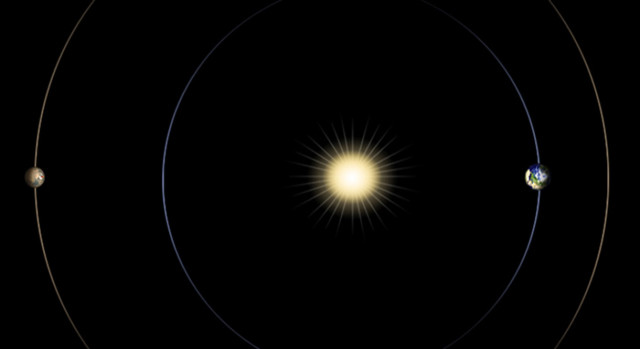Mars Solar Conjunction To Interfere With NASA Calls To Orbiters And Rovers In April

April will be a relatively quiet month for the rovers and orbiters that we’ve sent to Mars, thanks to a conjunction between the sun and the neighbor planets.
A Mars solar conjunction -- when the Red Planet, sun and Earth are aligned -- happens about once every 26 months, so this isn't NASA's first rodeo. The space agency is already taking steps to prepare for the alignment.
"This is our sixth conjunction for Odyssey," Chris Potts of the Jet Propulsion Laboratory, mission manager for NASA's Mars Odyssey orbiter, said in a statement. "We have plenty of useful experience dealing with them, though each conjunction is a little different."
This year’s conjunction will culminate in an arrangement where the apparent angle between Mars and the sun, from our perspective, is about .4 degrees, as seen in this illustration:

The positioning of the sun between Mars and the Earth will disrupt radio transmissions between the two planets, so NASA won’t be able to communicate as effectively with its craft.
Sometimes the interference of the sun is intensified by solar activity, but all signs point to this latest cycle being relatively mild.
The Mars Science Laboratory, informally known as Curiosity, and its smaller sibling Opportunity, are the only surface objects on Mars that are still in operation. NASA also has two orbiters in operation: the Mars Reconnaissance Orbiter, which uses radar, spectrometers and cameras to analyze surface conditions and weather on the Red Planet; and the 2001 Mars Odyssey, which is searching for evidence of past water or volcanic activity. These satellites also help relay communications from the ground-based rovers back to Earth.
The European Space Agency also has its own orbiter, Mars Express, which will likely be taking a load off to wait out the solar conjunction.
To avoid dropping crucial calls, NASA is suspending transmissions from Earth to the orbiters from April 9 to April 26. On April 4, the Mars Reconnaissance Orbiter will enter record-only mode.
"For the entire conjunction period, we'll just be storing data on board," MRO mission manager Reid Thomas said in a statement.
Odyssey, meanwhile, will continue transmitting data throughout April.
Opportunity will also receive no commands between April 9 and April 26, but the rover isn’t exactly getting a break: The team will be sending long-term instructions for the robot to carry out during the silent period.
"We are doing extra science planning work this month to develop almost three weeks of activity sequences for Opportunity to execute throughout conjunction," Opportunity Mission Manager Alfonso Herrera of JPL said in a statement.
Curiosity will also be continuing to make observations on its own, with the rover’s team suspending their direct commands from April 4 to May 1. Curiosity will still be sending “beeps” back to Earth, via Odyssey.
Once Mars emerges from behind the sun, NASA engineers will get an April shower of several weeks’ worth of data.
© Copyright IBTimes 2025. All rights reserved.





















